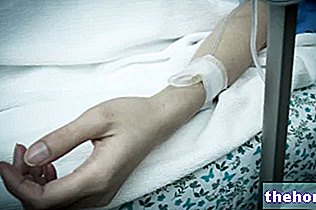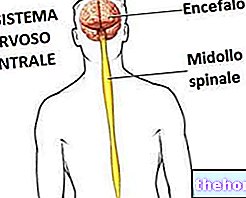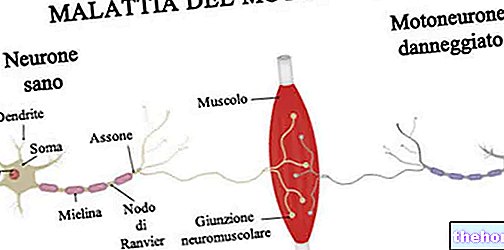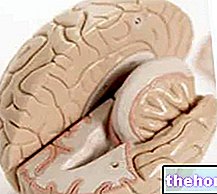Febrile convulsion: definition
More than a single clinical entity, febrile seizures constitute a syndromic variant that groups different types of simple and / or epileptic seizures. Although the chances that a child suffering from a febrile convulsion will develop epilepsy are quite low, the advice of the doctor and, possibly, hospitalization is always essential.
Today, thanks to the improvement of diagnostic and therapeutic techniques, febrile convulsions must be considered a benign form, which is well distinguished from epilepsy. It should be pointed out again that the consequences of a single episode of febrile convulsion (or even of several attacks spaced out over time) are scarce, almost nil. In fact, in the absence of CNS alterations, simple febrile seizures do not increase the risk of death, brain damage or mental retardation.
In this article, febrile seizures are analyzed in terms of symptoms, diagnosis, and therapy. Let's see in more detail.
Causes
The target of febrile seizures is represented by healthy children aged between 6 months and 6 years, although statistical surveys also document younger infants and older children affected by the same disorder.
The vast majority of febrile seizures occur within 24 hours of the sudden onset of fever (> 38-38.5 ° C). Ear diseases (eg otitis), as well as any pathology of viral or bacterial aetiology (eg rubella, sixth disease, flu, etc.) can expose the child to the risk of febrile seizures.
Some sporadic cases of febrile convulsion have been reported as a result of much more serious pathologies, such as encephalitis or meningitis: in such situations, the condition of the child can degenerate within a short time, since we are faced with an involvement of the central nervous system .
- Remember, however, that similar pathologies can cause convulsions even in the absence of fever.
A certain correlation between some vaccinations and the outbreak of a febrile seizure has been documented. Some vaccines - such as tetanus-diphtheria-pertussis or measles-mumps-rubella vaccines - appear to expose the child to the risk of a febrile seizure. In such situations, spastic crises are still due to fever (a typical side effect of vaccination in newborns) and NOT to the vaccine itself.
The pathogenesis of febrile seizures is not fully understood: however, it seems that an intertwining of age, environmental factors and genetic predisposition is heavily involved.
Deepening: Genetic predisposition and febrile convulsions
Although it is established that family history plays a major role in the etiopathogenesis of febrile seizures in children, the precise mode of transmission has not yet been demonstrated. Some hypotheses have been formulated: it seems that the disorder can be transmitted through a complicated autosomal-dominant, autosomal recessive or polygenic mechanism. Thanks to numerous studies by linkage, 4 gene loci could be identified: FEB1, FEB2, FEB3 and FEB4. These studies of linkage they allow to identify the precise chromosomal position of a locus responsible for a given genetic disease: it is a useful approach for the determination and mapping of some genes responsible for genetically transmitted diseases.
Risk factors
A certain correlation was observed between the incidence of febrile seizures and some risk factors. The most vulnerable subjects from this point of view are:
- premature babies
- children with HSV-6 (Herpes virus type 6) infections
- children affected by viral infections in general
- children with family members with a previous history of febrile seizures
Clearly, CNS disorders also predispose the patient to febrile seizures.
In addition to these risk factors listed above, other predisposing elements have been identified the recurrence of febrile convulsions. Some pediatric patients, in fact, tend to develop other febrile seizures after the first seizure; the recurrence of such episodes is favored by some risk factors:
- The first seizure occurred within 6-12 months of the baby's life. In this case, it is very likely that the little patient will develop new seizures within a year of onset
- The first episode of febrile seizure is induced by a relatively low fever (<38 ° C)
- The duration of the first seizure lasts over 15 minutes
- Genetic predisposition
- Concurrent critical events during the first seizure
Common symptoms
The symptoms that distinguish febrile seizures vary according to the severity of the disease. In most affected children, the febrile convulsion begins with the "rolling" of the eyes and stiffening of the limbs. Subsequently, the child loses consciousness and, involuntarily, repeatedly contracts and relaxes the muscles of the lower and upper limbs. Loss of control of the anal and bladder sphincter is not uncommon during this phase. Febrile seizures, causing breathing difficulties, can induce a cyanotic state in the baby.
When the febrile seizure lasts longer than 10-15 minutes, the child may also experience severe breathing problems, extreme sleepiness, vomiting and a stiff neck.
The appearance of multiple episodes of febrile convulsion in the context of a single viral disease must be considered a serious medical emergency.
Investigations
The diagnosis of a febrile seizure is considered relatively simple. The investigation is carried out following the story of the critical episode (almost never observed by a doctor!) And subsequently confirmed by neurological examination.
In a healthy child, the neurological examination should possibly be repeated to deny the hypothesis of a possible - albeit unlikely - involvement of the central nervous system. In the event of suspected damage to the CNS (eg serious infections, meningitis, concomitant neurological diseases), lumbar puncture (rachycentesis) is recommended, always to be performed after a CT scan or MRI.
The differential diagnosis with febrile syncope is important.
Specific laboratory tests are not indicated for diagnostic confirmation.
The encephalogram (known to most by the acronym EEG) of a child suffering from a single episode of febrile seizure is usually normal. If the fever has not yet dropped, it is recommended NOT to subject the little patient to this diagnostic test: the alteration of the basal temperature could alter the test.
Some authors are convinced that the EEG in a healthy child is not essential for the diagnosis of a febrile convulsion, since in the vast majority of cases (if not almost all) it is normal. Other researchers, on the other hand, believe that the EEG - following the febrile convulsive event - is essential for further denial of the possible damage to the CNS. We remind you that the EEG examination is able to reveal specific or non-specific intercritical anomalies in an early and often unambiguous way.
Therapies
In most cases, febrile seizures are a self-limiting event: in the absence of pre-existing brain damage, the prognosis of febrile seizures is excellent, therefore no specific treatment is required.
Contrary to popular belief, it is not essential to lower the fever immediately to stop a febrile crisis. Therefore, it is strongly NOT recommended to administer antipyretics by mouth during the seizure: the child would risk suffocation. For the same reason, it is recommended not to immerse the child in cold water. Most febrile seizures resolve themselves in a couple of minutes, leaving no brain damage to the baby.
The clinical picture takes on a more serious significance in the event that the seizure lasts more than 15 minutes: in this case, the febrile convulsion is a full-fledged medical emergency. In such circumstances, the doctor will administer specific drugs rectally or intravenously, to stop the seizure. The most common treatment consists in the rectal administration of benzodiazepines (eg diazepam): these powerful drugs interrupt the convulsion, therefore the crisis in progress.
Clearly, after having treated the main symptom (convulsion) it is necessary to proceed with the treatment of the disease that triggered it all.
Prognosis
The SHORT-TERM prognosis is for relapsing forms of febrile seizures.
In general, following a first febrile seizure, the risk of recurrence is estimated at around 10%. This figure just reported is influenced by the age of onset of the crisis, the extent of the fever and the underlying diseases. The risk increases up to 25-50% in conjunction with one or two risk factors (eg genetically predisposed subjects, appearance of the first crisis before 6 months, etc.), up to 50-100% in children with more than three risk factors.
The LONG-TERM prognosis defines the risk of degeneration of the seizure into epilepsy itself.
From what is reported in the scientific journal BJM journal (Clinical research ed.), it appears that the chances of developing epilepsy increase in conjunction with:
- complex febrile seizures
- neurological abnormalities
- family predisposition
- manifestation of the convulsion less than an hour after the outbreak of the fever.
In the absence of the aforementioned characteristics, 2.4% of children with a previous history of febrile seizures are still at risk of epilepsy.
Administration of phenobarbital and sodium valproate was completely INEFFECTIVE for to prevent the degeneration of febrile convulsions in the context of epilepsy. We also remember the side effects related to the excessive use of these medicines, linked in particular to the cognitive sphere.
Prevention of relapses
The prophylactic treatment continuous with antiepileptic drugs for the prevention of relapsing febrile seizures is strongly discouraged.
The so-called "intermittent"Relapsing seizures with benzodiazepines is possible in some specific cases (eg very early age of onset, very frequent relapses, pre-existing neurological deficits, etc.). The most used drugs for this purpose are phenobarbital and sodium valproate.
The recommended is instead preventive treatment of hyperthermia: water sponging, the temporary application of ice on the head and the administration of antipyretics every 4-6 hours (in case of basal temperature above 37.5 ° C) are particularly useful measures to keep fever under control, especially in children predisposed to febrile seizures.
More articles on "Febrile Seizures: Symptoms, Diagnosis, Therapy"
- Febrile seizures
- Convulsions
- Convulsions: classification, diagnosis and therapy
- Febrile seizures: Symptoms, Diagnosis, Therapy




























